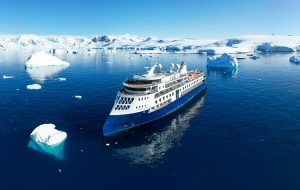
As I settled into my seat, a senior Qantas crew member approached with an offer to upgrade into business.
“Thanks very much, but this is really good and I am comfortable here,” I responded, so impressed was I by the space and service in the cabin.
I have watched closely ever since as premium has continued improve as airlines up their game.
“We’ve seen premium economy attracting strong and consistent growth,” Flight Centre CEO Graham Turner says. “Premium now represents three per cent of our seat numbers, and considering not every airline has it, that’s significant.”
Adds Jesse Leung of TripAdvisor Asia Pacific, “Over the past six months, we’ve seen a double-digit increase in searches for premium by Australian travellers.”
It’s a similar story on Webjet, with CEO David Galt stating, “The number of premium flights booked on Webjet between 2017 and 2019 has grown 50 per cent.”
THE NEXT BATTLEGROUND
In the 2019 Skytrax awards, Virgin Atlantic, Singapore Airlines and Air New Zealand were named the world’s top three premium economy airlines. Qantas came in sixth and Virgin Australia eighth. In recent years, premium has been introduced on Singapore Airlines, American Airlines and Delta, and next year, Emirates and United will launch their versions.
Premium economy is now at something of at a pivot point, with new seats, configurations, cabins, service standards and a range of extras either in place or on the way. And with Qantas announcing it is increasing the size of the premium cabin by 27 per cent in readiness for ultra-long haul direct flights to London and New York, it understandable premium is being called ‘the next battleground’. Here’s a look at what’s on the way.
PREMIUM ECONOMY: IS IT WORTH IT?
BEST PREMIUM ECONOMY AIRLINE SEATS
THE TRUE COST OF PREMIUM COMFORT
TAKE A SEAT
While there are variations between airlines, the average premium seat is about 45 to 49cm wide, with around 94 to 104cm of pitch between seats.
Qantas will up the ante in the coming months with updated premium cabins on the A380 fleet, with seats 10 per cent wider at 57cm in a 2-3-2 configuration. Other significant improvements include an ergonomic headrest, an extended foot rest, larger tray table and increased storage.
“This upgrade is a major investment in putting the next generation of seats on the aircraft as well as more creature comforts to maintain its status as one of the best ways to fly,” Qantas CEO Alan Joyce says. “We’re seeing increased demand for premium economy and business class on the long haul routes that the A380 operates.”
Emirates is tight-lipped about its plans for its new premium seat, but it’s tipped it will use the ‘Eclipse Seat’, which offers a staggered configuration and angled seating in a ‘Z shape’, within a fixed shell. It’s a dramatic departure from the regular premium seat.
Eclipse’s creator HAECO Cabin Solutions has confirmed it will be launched on an undisclosed Middle Eastern airline. With neither Etihad nor Qatar announcing plans for premium, Emirates seems the sure bet.
Over in Auckland, Air New Zealand is busy in its Hangar 22 seating project for the future cabin experience on its widebody aircraft. The airline gave its 777-300 aircraft a $100 million overhaul only two years ago, including a premium refit. It’s now looking at another overhaul for the cabin.
“We’re pushing the boundaries of what’s possible,” Air New Zealand’s GM of customer experience Nikki Goodman says. “We believe premium economy is the cabin with the greatest scope to innovate.”
ON THE INSIDE
Rob Burgess on the site Headforpoints predicted earlier this year, “The premium economy revolution may be coming.” As part of that revolution, many airlines are bumping up premium features, with special attention to the cabin design.
On Qantas, the A380’s expanded premium cabin will now have 60 seats, and on the Dreamliner, 28. It’s an ever bigger story on Singapore’s A350-900 fleet, which now has a cabin of 94 premium seats.
On the other end of the scale, Air New Zealand’s 777-200ER Premium has only 40 seats, Virgin Australia’s Boeing 777 has 24 seats, as does JAL’s 789. Both Air NZ and Virgin Australia offer extended legroom, with a seat pitch of 104cm.
“With more legroom than any other Australian airline, the exclusive cabin enhances our award-winning service,” a Virgin spokesperson said.
Cathay Pacific Premium underwent a recent renovation that now includes extra on-board storage spaces, larger tray table and even a cocktail table. “These features allow some of the perks from business class to be accessible to premium economy travellers,” a Cathay Pacific spokesperson said.
ADDED EXTRAS
Then there’s the extras across the airlines that add the little something to the premium experience.
On Virgin Australia, there’s a self-serve pantry of drinks and snacks as well as a Nespresso machine. Singapore Airlines has the ‘Book the Cook’ service, where you can pre-order the main meal from a range of dishes. Premium meals are dished up on crockery and include silverware on carriers like Qantas, British Airways and Virgin Australia.
If privacy is your thing, JAL’s premium now has a screen to further separate the seats. And Qantas, VA and Air NZ all have a separate premium loo.
“As the competition between carriers increases, you can expect to see much more included as extras in the premium offering,” Flight Centre’s Graham Turner says. “These are the features that especially matter to passengers on long-haul flights.”
AT COST PRICE
Premium fares vary as much as the standard between the airlines, and with more changes ahead, there’s sure to be bargains and deals to be had.
“Over recent months, Singapore Airlines, Qantas and Cathay Pacific emerged as the most-searched for carriers among Australian travellers when searching for premium economy fares,” TripAdvisor’s Jesse Leung says.
For a Sydney to Los Angeles Premium return trip in mid-November, a Qantas premium fare starts from $4340, Air New Zealand from $2294 and Virgin Australia from $4337. Fares from Melbourne are Qantas from $4342, Air NZ from $2278 and VA from $4373.
For a Melbourne to London premium return in mid-November, Qantas starts from $4437, Singapore Airlines from $3669 and Cathay Pacific from $3741. A Qantas premium fare from Sydney to London starts from $4412 and from Perth is $5695. Cathay from Brisbane is from $3764.
BUSINESS CLASS FLIGHT NO ONE TALKS ABOUT
BUSINESS CLASS IS SUDDENLY GOING CHEAP
KNOW THE DIFFERENCE
Not all premium is created equal. On some airlines, it’s more a case of business-minus, and on others it’s like economy-plus so it’s important to know what you are paying for, especially when standards are shifting.
“Inclusions in a premium economy fare vary between airlines,” Webjet’s David Galt says. “One of the most important differences is to understand seat type and other variations.”
As premium faces a shifting, ever-changing landscape into the future, it means passengers are likely to emerge the winners.
“With more premium products in the market, airlines could try to outdo each other in getting the right products and pricing, which will benefit the consumer,” TripAdvisor’s Jesse Leung says.
One thing’s for sure — flying in the middle of the plane is about to become a lot more interesting.














